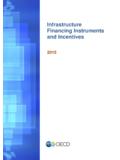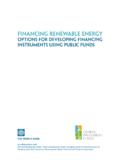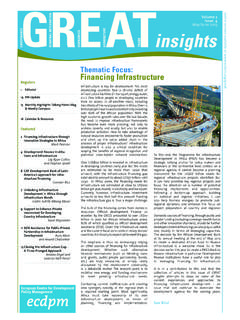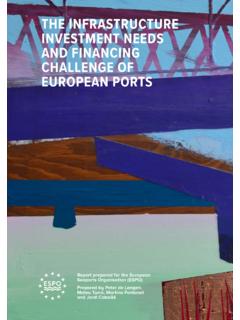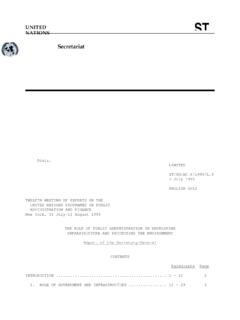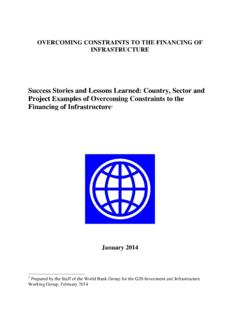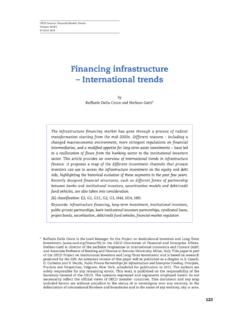Transcription of An introduction to market-based instruments for ...
1 12 An introduction to market - based instruments for agricultural price risk management agricultural MANAGEMENT, MARKETING AND FINANCE WORKING DOCUMENT agricultural MANAGEMENT, MARKETING AND FINANCE WORKING DOCUMENT 12 An introduction to market - based instruments for agricultural price risk management Myong Goo Kang Nayana Mahajan agricultural Management, Marketing and Finance Service (AGSF) agricultural Support Systems Division FOOD AND AGRICULTURE ORGANIZATION OF THE UNITED NATIONS Rome, 2006 The agricultural and Food Engineering Working Document disseminates findings of work in progress to encourage the exchange of ideas and experiences related to agricultural and food engineering within agri-food systems.
2 The series aims to bring the findings to the public domain as quickly as possible, even if the presentations are less than fully polished. The papers carry the name of authors and should be used and cited accordingly. The findings, interpretations and conclusions are the author s own. The designations employed and the presentation of material in this information product do not imply the expression of any opinion whatsoever on the part of the Food and Agriculture Organization of the United Nations concerning the legal or development status of any country, territory, city or area or of its authorities, or concerning the delimitation of its frontiers or boundaries. All rights reserved. Reproduction and dissemination of material in this information product for educational or other non-commercial purposes are authorized without any prior written permission from the copyright holders provided the source is fully acknowledged.
3 Reproduction of material in this information product for resale or other commercial purposes is prohibited without written permission of the copyright holders. Applications for such permission should be addressed to: Chief, Publishing Management Service Information Division FAO Viale delle Terme di Caracalla, 00100 Rome, Italy or by e-mail to: FAO 2006 ContentsPREFACEvACKNOWLEDGEMENTSviiABSTR ACTixI. PRICE A STABILIZATION APPROACH TO A market - based APPROACH2II. instruments FOR COMMODITY PRICE RISK SUMMARY AND OF THE market - based PRICE RISK MANAGEMENT FOR ENCOURAGING THE USEOF market - based PRICE MANAGEMENT INSTRUMENTS30 REFERENCES35 ANNEX1: KEY agricultural COMMODITY EXCHANGES IN THE WORLD39 ANNEX2: A BRIEF HISTORY OF market - based INSTRUMENTSOF PRICE RISK MANAGEMENT41 ContentsiiiPrefacePrice risk management is very critical to the success of agriculture, and yet there is a lack oftools used to manage risk as well as a lack of understanding of the tools themselves.
4 Comparedto the industrial sector, agriculture is exposed to many more unpredictable risks anduncertainties. Through the supply chain, from the stage of production to marketing, agricultural performance is highly dependent on many exogenous variables. Crop output andproductivity are highly susceptible to uncontrollable factors such as climatic disruptions,natural hazards and pest attacks. Physical risks such as pilferage and deterioration can result ina considerable loss of value during storage and transportation. Trading risks of non-deliveryand counterparty default also reign high. In many countries, faulty and distortionarygovernment policy incentives have resulted in agriculture planning being highly unresponsiveto market the undercurrents of the long-term secular decline of commodity prices haveimpoverished many developing countries, scourges of short-term price volatility manifestthemselves in many ways.
5 Revenue uncertainty not only threatens the livelihoods of theagriculturists, but limits farm credit, trapping them in vicious cycles of low investment. The commodity problem has been rightly described as a combination of declining terms of trade( commodity prices rising less rapidly than those of manufactured prices) and price volatility(Page and Hewitt, 2001).Commodity price risk management is not a new idea. The failure of international efforts suchas stabilization funds and international commodity agreements in stemming commodity pricefluctuations has been well known. Loss of safety nets due to global free trade and changes indomestic agricultural policy has only added to this vulnerability. This paper focuses on the useofmarket- based instruments for managing agricultural price risk.
6 market - based mechanismsessentially entail shifting risks to entities in a better position and more willing to bear market - based , these could also externalize risks outside the country. Their success doesnot hinge on government treasuries, and in some cases, could allow governments to disengagefrom costly and counterproductive not the subject of this paper, it must be mentioned that some of these instrumentseffectively serve as an alternate agri-marketing system, providing a market , price and agri-infrastructure, and can be of relevance in many strategic agri-planning decisions. It should alsobe mentioned that farmers do not necessarily have to use these instruments to benefit fromthem. Even basic market reading and access to the disseminated prices can boost theirbargaining power towards getting market -linked prices.
7 Most of the instruments introducedhere have a long history and are actively traded in many markets. It is unfortunate that lack ofawareness and know-how among developing countries has limited their widespread use and hasresulted in lagged critical benefits to developing paper is designed to acquaint the reader with these market - based instruments . The subjectis relevant for any entity associated with or impacted by the integrated areas of agriculturalmarketing and financing. It is hoped that this paper will help readers better appreciate theadvantages of managing risks through markets and give them a clear understanding of theunderlying mechanisms as a basis for applying these instruments to better manage their pricerisk.
8 The potential of applying these price risk management instruments to enhance agriculturemarketing and financing is incalculable. While case studies are provided to aid readers understanding and appreciation of these instruments , this paper does not deal with theapplication of these introduction to market - based instruments for agricultural price risk managementAcknowledgementsAn introduction to market - based instruments for agricultural price risk managementis based on Innovationsof agricultural commodity price risk management: an approach to market - based instruments (2005) byMyong Goo Kang, former Rural Finance Expert of FAO and now with the Korean Ministryof Agriculture. The paper was then revised and elaborated on by Nayana Mahajan, formerresearch consultant, UN Conference on Trade and Development (UNCTAD), and currentlyAssistant Manager with the Multi Commodity Exchange (MCX) India.
9 The authors sought todiligently describe and exemplify concepts and tools in a comprehensible and easy-to-understand manner for all authors and FAO would also like to thank Barbara Hall, who has extensively edited thedocument. Special acknowledgement is given for the incisive guidance of Lamon Rutten,former Chief, Commodity Finance and Risk Management, (UNCTAD) and currently head ofMCX India, the encouragement of Shivaji Pandey, former Director, agricultural SupportSystems Division, and Doyle Baker, Chief of the agricultural Management, Marketing andFinance Service (AGSF), who fully recognized the importance of agricultural riskmanagement. Many thanks go to Calvin Miller, Senior Officer of the Rural Finance Group(RFG), AGSF, who was a permanent adviser and mentor in the research and writing of thepaper.
10 Finally, special thanks go to Trish Fosh e, Director, Sales and Marketing, Institute forFinancial Markets, Washington DC, , who helped clarify concepts and present instruments for managing agricultural price risk are a practical and non-intervening alternative for managing commodity price volatility. This market - based approachdiffers significantly from the often failed national and international regimes of price , they have been less embraced in developing countries where institutionalstrength and a mere lack of awareness of the use of the instruments have deprived thesecountries of their paper focuses on five of the most important instruments of price risk I covers an introduction and discusses commodity price risks and the change from astabilization approach to a market - based one.










